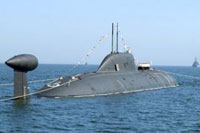Russian Nuclear Submarines Approach Canada
The Russian nuclear submarines, which previously were noticed not so far from the US East Coast, have now approached Canada. Canadian Air Force began to monitor their navigation, the nation’s Defense Minister Peter McKay said.

The submarines are staying in international waters and do not violate any agreements, RBC news agency said.
"The submarines have not done anything threatening," Dan Dugas, spokesman for Canadian Defense Minister Peter MacKay, told AFP.
"They're in international waters" in the North Atlantic, he said. "They're allowed to be there. But our job is to ensure that our coastal perimeter and waters are respected."
Pentagon officials told reporters last week that two Russian nuclear submarines were patrolling the US East Coast. The officials did not express any concerns about it, although they said that it was the first time since the Cold War when the submarines of a “potential enemy” approached the US territory so close.
Anatoly Nogovitsyn, a senior spokesman for the General Staff of the Russian Federation, said that the fact that Russian nuclear submarines appeared near the USA and Canada was absolutely normal. Russian sources said that the submarines had never stopped patrolling international waters. “ Any drama about that is inappropriate ,” the official said.
Project 971 (Shchuka-B, 'Shchuka' meaning ‘pike,’ NATO reporting name "Akula"), is a nuclear-powered attack submarine (SSN) first deployed by the Soviet Navy in 1986. The class is sometimes erroneously called the "Bars" class, after one of its members. Note that Akula ("shark") is the Soviet designation of the ballistic missile submarine class designated by NATO as the Typhoon class submarine.
There are three sub-classes or flights of Shchuka, consisting of the original seven "Akula I" submarines which were built between 1982 and 1986, five "Improved Akula" submarines were built between 1986 and 1991, and two "Akula II" submarines were built from 1991. This information is disputed, however, as the distinction between the Improved Akula and the Akula II class is debated by authoritative sources. The Russians simply call all of the submarines Schuka-B, regardless of modifications, and it is rumoured that no two are alike.
The Akula incorporates a double hull system composed of an inner pressure hull and an outer "light" hull. This allows more freedom in the design of the exterior hull shape, resulting in a very hydrodynamic submarine compared to western counterparts at the time.
The distinctive "bulb" or "can" seen on top of the Akula's rudder houses its towed sonar array, when retracted.
All Akulas are armed with four 533 mm torpedo tubes which can use Type 53 torpedoes or the SS-N-15 Starfish missile, and four 650 mm torpedo tubes which can use Type 65 torpedoes or the SS-N-16 Stallion missile.
Russia currently has 14 Akula class submarines. The last one of them was launched in 2001. Russia is currently building the K-152 Nerpa sub, which made headlines last autumn after 20 people were killed during a test process on board.
Subscribe to Pravda.Ru Telegram channel, Facebook, RSS!



